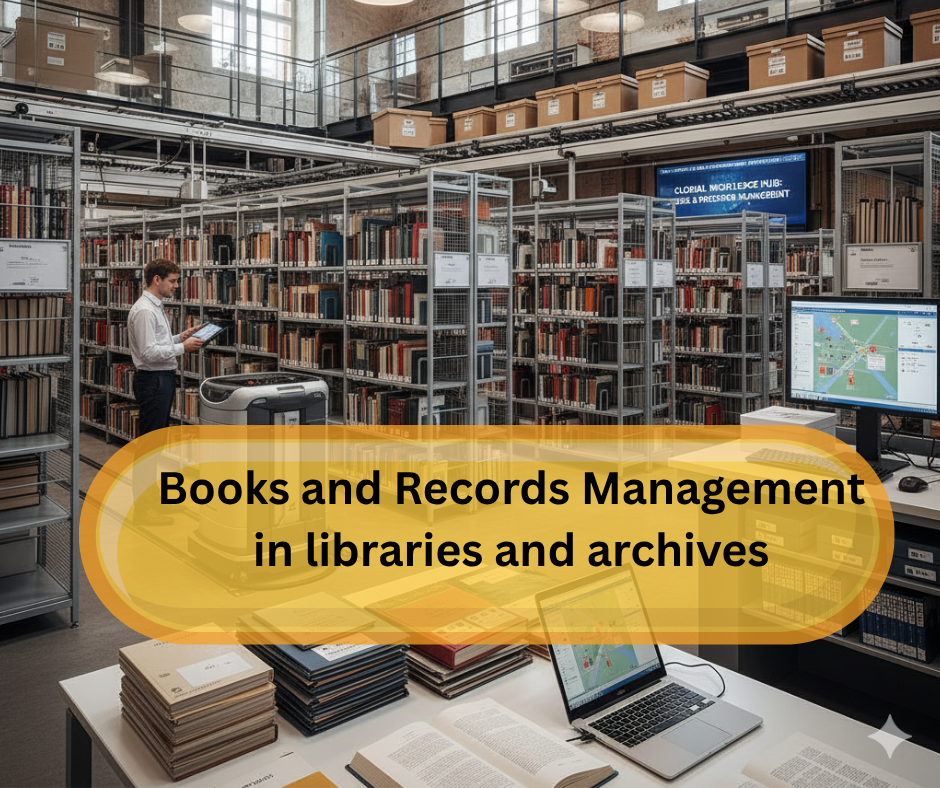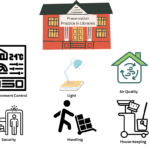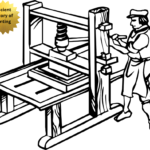People have had a natural desire to preserve since the beginning of time. It has been manifested, particularly through the nurturing of ideas. When creative ideas are recorded and given form, people take action to ensure their permanence. The library institution was founded on the idea of determining the proper methods of preserving books, books, and records, which are referred to as the institution’s soul. As a result, the discussion will focus solely on the institutions’ preservation programs.
Terms of Books and Records Management
At the beginning, three terms are discussed. These have been widely discussed recently. Specifically: Preservation, Conversation and Deterioration. If the internal concepts of the terms are understood, the discussion on preservation is easily understood.
1. Preservation is the proper management and safekeeping of all information materials collected in libraries, archives and similar institutions and the information contained therein. Along with this, the policies, technologies, processes and procedures and the officials and employees engaged in their maintenance are all included in the preservation program. Therefore, it can be said that the word ‘preservation’ for libraries is a very comprehensive concept and its scope is very wide.
According to the ALA Glossary, preservation refers to the activities involved in keeping library and archive materials available for use, either in their original psychological form or in another way.
2. The Advanced Learner’s Dictionary defines Conservation as “the prevention of loss, waste, damage, and destruction.” From that point of view, the word means ‘preservation’ from any loss or damage. That is, the process and method by which the information materials and information of libraries and archives are preserved and the method by which the said information materials are protected from destruction, extinction or destruction – in the language of book preservation, it is called conservation.
“According to IFLA, a term that denotes those specific policies and practices involved in protecting library and archive materials from deterioration, damage, and decay, it includes the methods and techniques devised and undertaken by technical staff. Common conversation techniques include DE acidification, encapsulation or lamination, and preservation microfilming (Harrods’s Librarians’ Glossary)
The use of chemical and psychological procedures in treatment or storage to ensure the preservation of books, manuscripts, records, and other documents. (ALA Glossary, 1983).
3. The third term mentioned is ‘Deterioration’. The deterioration of the natural quality of a document is called Deterioration.
The Advanced Learner’s Dictionary defines Deterioration as “become worse in quality or condition”. Such deterioration can occur in two ways. First, the material in which the data/information is contained is no longer able to be preserved, i.e. the internal capacity has been lost; or second, the external condition of the material is the cause of its deterioration. Here, internal causes are the actual causes of its deterioration within the material itself. On the other hand, external causes can be identified as maintenance and usage errors and negligence.

Materials: Internal Causes of Deterioration
Librarians and archivists draw on their long-standing knowledge to understand the reasons why books and records deteriorate quickly. The following are discussed under separate headings:
- Structure of Paper: The material from which paper is made contains all the elements that can absorb moisture from the air. When water comes in contact with paper, it gets damaged. The chemicals used in the production of paper react with excessive light and the print gets damaged. Due to these reasons, there is a risk of destruction of library and archive materials and records.
- Ink: The life of the printed/written materials depends largely on the durability of the material from which the ink is made. Therefore, the role of printing/writing ink is also very important in the destruction of documents. Besides, nowadays, various types of microforms are kept in libraries and archives institutions. If the quality of these materials is not improved, microfilms are kept. If the quality of these materials is not improved, the life span is short. Therefore, it is not uncommon for library materials to be destroyed due to poor quality ink rather than the desired quality.
- Optical Discs: In modern times, Video discs, Compact discs and other similar materials are widely used in advanced libraries and archive institutions. They are prepared scientifically through the use of laser light. Their lifespan depends on the technical quality. And it depends on the weather and environmental conditions. Namely, due to the lack of manufacturing process and the ruthlessness of technical quality, their destruction is accelerated in most cases. If these materials are kept in a different quality or undesirable environment instead of keeping the desired environment in the place where light, heat and air are controlled, there is no doubt that their destruction will be accelerated.
External Causes of Deterioration:
Not only internal factors are responsible for the deterioration of library and archive materials, but the environment of the building in which the library and archives are located, the weather conditions, etc. accelerate the deterioration of the materials. Some of these factors are discussed below:
Temperature and relative humidity:
Temperature and relative humidity play an important role in the maintenance of library and archival materials. Books, documents, magnetic items, discs, films and other similar materials require a suitable environment in which to store them. But in most underdeveloped countries, due to lack of knowledge, financial constraints or negligence, these items are stored in some way. This situation is responsible for a considerable amount of material deterioration. Just as the items mentioned above get fungus due to lack of adequate light, they also get damaged by excessive sunlight. Care must be taken in these matters.
Environmental Pollution:
The impact of the environment plays a very important role in the maintenance of the equipment. In fact, environmental pollution is identified as one of the main reasons for the destruction of archives and library items by reducing their lifespan. In most of the industrialized countries or industrialized areas of the world, the libraries are affected by air pollution and the libraries are destroyed as a whole. Sulfur and nitrogen from industrial cities come and mix with the air. Many people are unaware of the good way to protect the libraries as a whole from the corrosive effects of these. Therefore, environmental pollution is responsible for the destruction of libraries.
Biological agents:
Most of the life-destroying microorganisms act as the cause of destruction of library materials. For example: molds, fungi, insects, etc. Due to dust, inadequate ventilation, inadequate light, high temperature, low/high humidity, etc., such an environment is created inside the library that is disturbed naturally. As a result, insects, pests, etc. are born. Due to which it is not difficult and difficult to save the information materials from these damages by taking appropriate measures.
Natural Causes:
Due to natural disasters such as floods, earthquakes, fires, which are almost beyond human control, almost all libraries are severely damaged. However, if proper precautions and timely pre-planning are taken, not only the library as a whole, but many things can be saved from complete destruction.
Man-made causes:
It is essential to take proper care and maintenance of books, documents, or any kind of library material to increase its lifespan. If these are not used with caution, damage to them is inevitable. The physical destruction of a book occurs due to clumsy use – clumsy use can be caused by both staff or readers. Besides, some people have such a mentality that they turn up their noses at books.
For some reason or another, people fold the pages of books, put pens, pencils or other things inside the books to mark the pages to understand how far they have read, and draw marks to convey importance through the text. These factors accelerate the damage to library materials. Even after these obstacles, it is advisable to remember that these only cause temporary damage to the books. But dust, water, food and drinks, direct sunlight and pressure greater than the amount of pressure that the book can withstand are identified as causes of damage to the books.
A librarian or archivist should preserve and safeguard his collection, i.e. library materials, by keeping them safe from various types of damage, both internal and external. He should ensure the storage facilities of the library collections in such a way that the materials are protected from various types of damage. Secondly: If there is a fear that the materials will be damaged due to any external reason, he should take precautions in advance. In addition, Librarian or Archivist will see what strategies or methods he can adopt to safeguard the materials, which will ensure maximum security for the materials.



